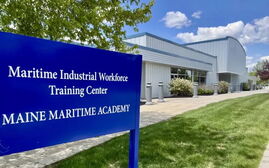Business Leaders: Tim Hebert has STARC Systems on a growth path for today's world
 Photo / Tim Greenway
Tim Hebert
Photo / Tim Greenway
Tim Hebert
In a world fraught with anxiety around a fast-moving virus, STARC Systems seems like a business custom-made for the times.
The Brunswick company manufactures clean barriers used by hospitals during construction. Dust and debris stay on the construction side, while the sterile, hospital side remains clean and infection-free.
In seven short years since its founding, Chairman Tim Hebert has guided STARC Systems into larger and larger workspaces at Brunswick Landing, and this year aims to have 80 employees. While the privately held company does not disclose sales figures, Hebert said those numbers doubled last year and are expected to double again this year. The company received private equity investment and, along with its larger production staff, has beefed up management ranks, with Hebert hiring a CEO, CFO and strong sales staff.
Later this spring, the company will consolidate two sites at Brunswick Landing, moving into 50,000 square feet in a former aircraft hangar on Orion Street.
“This is great story of conceiving, starting and growing a business in Maine and partnering with Maine’s innovative support ecosystem to accomplish their goals,” says Steve Levesque, executive director of Midcoast Regional Redevelopment Authority, which oversees development of Brunswick Landing, a former Navy base.
Roots in the construction business
Hebert, 40, is a Lewiston native who grew up around his family’s construction firm, Hebert Construction, which was founded by his grandfather, Edward Hebert, in 1943.
Today, he owns Hebert Construction 50/50 with a cousin, Mike Hebert.
“That is my day-to-day job,” he says. “I split time between the two companies — a lot of nights and weekends.”
Hebert Construction’s portfolio includes a range of hospital expansions. Its portfolio includes St. Mary’s operating room expansion, the Piper Shores complex and the Patrick Dempsey Center for Hope and Healing.
The more work Hebert Construction did in hospitals and health care, the more Tim Hebert started thinking about ways they could better contain the construction areas. He pursued the idea at night and on weekends.
“At first it was an idea,” he says, but soon he was applying for grants and patents and reviewing designs — “all stuff I could do on weekends,” he adds.
Within the first year, he brought on a mechanical engineer, Bruce Bickford, who he met at a Maine Technology Institute conference. Soon, they were collaborating on the design of the containment walls.
“He took the idea and made it something real,” Hebert says.
All the while, STARC Systems was very much in the startup phase. Hebert was sure there was a product there, but he didn’t yet know there was a demand.
“We were doing work at Maine Med. I got a call that a lady had tripped on a piece of debris,” Hebert says. He quickly responded.
“That night, instead of going home, I went to my office,” he says. “That really started things. We knew we needed to do something. That was the catalyst. Since then it’s been a series of fortunate events.”
He and Bickford, now chief operating officer, developed the first prototype to get feedback from the health care industry.
They hired a sales lead, Chris MacKenzie, and started producing the barrier walls.
A make or break year
That’s when things got real.
To start producing the main product, the barrier walls, STARC Systems needed working capital.
Hebert was able to get a line of credit from Norway Savings Bank by mortgaging his house. MTI provided some grant money and Hebert put in some of his own money. In all, the company had $200,000 in startup capital and a 2,000-square-foot space at Tech Place, the business incubator at Brunswick Landing.
“We were in rented space. We had no sales. I had two young boys. It was scary,” Hebert says. “My day job gave us the ability to live our lives.”
Yet like many startups, it had a make-or-break year.
By the second full year in business, 2015, the company was down to its last $5,000.
“We almost lost everything,” Hebert says. “We were $5,000 from bankruptcy.”
That was the turning point.
“There were three of us,” Hebert says. “We finally started pushing product out the door.”
Growth in health care field
While hospitals were originally considered a key sales target, it turned out construction companies liked the barrier system because it was easy to put together on site, it can be easily cleaned and it is reusable, meaning they can take it from site to site. Turner Construction, the world’s largest construction company, is a customer, Hebert says.
Hospital owners are still key advocates of the product, recommending STARC Systems to other hospitals.
In October 2017, the company received a $3.5 million investment from Blue Heron Capital, which helped propel production and allowed the company to expand its sales team.
Around the same time, STARC Systems hired a CEO, Chris Vickers, a Caribou native who had been CEO of the Vermont Country Store but was looking to move back to Maine.
“We needed Chris to help us get to the next level,” Hebert says.
Vickers says he wasn’t necessarily looking to lead a manufacturing firm, but immediately took to the staff and startup mentality.
“This was all the things I was looking for,” he says. “It’s exciting to be part of.”
Along with MTI, a critical partner has been Midcoast Regional Redevelopment Authority, which oversees development of Brunswick Landing.
“MRRA and Tech Place — that was a resource that just doesn’t exist elsewhere,” Hebert says.
Jeffrey K. Jordan, deputy director of Midcoast Regional Redevelopment Authority, says STARC Systems has been a poster child for growth on the campus.
“[It] grew very rapidly,” Jordan says. “They kept asking for more and more space in our business incubator.”
STARC Systems went from 2,000 square feet to 16,000 to over 35,000 square feet. Today, the company has manufacturing on one end of Orion Street and offices at the other end.
By May, the company will move into a 50,000-square-foot aircraft hangar, along Orion at Brunswick Landing.
By leasing space rather than building, STARC Systems “has been able to use our capital for growth instead of real estate,” Hebert says.
The company continues to hire. Hebert says he’s been heartened by the number of new hires who have been referred by other employees.
Hebert and others on the management team built the company, but, he adds, the employees are creating the culture.
“We’re Maine-based, we believe in quality,” he says.













0 Comments